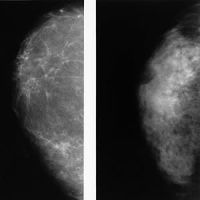Researchers from Medical University of South Carolina conducted a study to determine the impact of 5th edition BI-RADS breast density assessment guidelines on density reporting patterns in their institution. While an overall increase in the dense assessments using the 5th edition was observed, individual radiologists showed a variable adaptation to new guidelines.
According to the researchers, the additional patient population that was labelled as having dense breasts by virtue of the new guidelines may benefit from supplemental screening to detect additional small, mammographically occult breast cancers. Their study is published in the American Journal of Roentgenology.
Mammographic breast density is an important variable that can affect the sensitivity of mammography for the detection of breast cancer. However, the assessment of breast density on mammography is not a perfect science, and assessment can vary from one reader to another. Breast density is routinely assessed by radiologists using American College of Radiology (ACR) guidelines issued from time to time in BI-RADS. According to the 4th edition of BI-RADS, the density was assessed as an approximate percentage value of the fibroglandular tissue in relation to the whole breast area on a mammogram. In the 5th edition guidelines (released in 2013), this percentage-based system was removed, and more emphasis was put on the masking effect of dense tissue.
One significant change in the new guidelines pertains to the reader’s freedom to categorise the breast as dense (even if it is ≤ 50% glandular) when a focal patch of dense tissue seems to raise enough concern to the reader that it could mask an underlying cancer. Because of this change, one may expect a higher rate of dense assessments with the new guidelines compared with the 4th edition
In the current study, PenRad reporting system was used to collect mammographic breast density data reported by five radiologists: 16,907 density assignments using 5th edition BI-RADS guidelines were compared with 19,066 density assessments using 4th edition guidelines. Changes in the density assessment pattern were noted between the 4th and 5th edition guidelines, and agreement in density distribution was compared using the intraclass correlation coefficient. A chi-square analysis was conducted for each reader to examine the change in the proportion of dense versus nondense assignments and on each category type to examine specific changes in proportion of density assignments from the 4th to the 5th edition. All reported "p" values are two-sided, and statistical significance was considered at the p < 0.001 threshold.
The researchers reported these key findings:
- Using the 5th edition, there was an overall 5.0% decrease in fatty assessments (p < 0.001), 2.8% increase in scattered densities (p < 0.001), 2.6% increase in heterogeneously dense (p < 0.001), and 0.4% decrease in extremely dense assessments (p = 0.15).
- Comparing the dense with nondense categories, there was a 2.3% overall increase in the dense assessments (p < 0.001) using 5th edition guidelines, mainly in the heterogeneously dense category.
- Two radiologists showed increased dense assessments (p < 0.001) using the 5th edition, and three radiologists showed no change (p = 0.39, 0.67, and 0.76).
"In our current study, we looked at the outcome from our routine clinical practice and confirmed an overall increase in dense assessments with 5th edition guidelines. However, the increase in dense assessment was not as pronounced as was seen in our previous study (2.3% increase in current study vs. 9.8% increase in previous study). This difference can be explained (as we speculated in our previous study) by the fact that breast density was the prime focus of attention in our previous study, whereas in routine clinical practice readers are usually more consumed in searching for breast cancer and may pay only superficial attention to the breast density assessment," the authors write.
A larger and multicentre study comparing density distribution datasets obtained from routine clinical practice using the 4th and 5th edition guidelines may give more accurate results, the authors say.
Source: American Journal of Roentgenology
Image Credit: Lee Health
Latest Articles
dense breasts, BI-RADS guidelines, breast density assessment
Researchers from Medical University of South Carolina conducted a study to determine the impact of 5th edition BI-RADS breast density assessment guidelines on density reporting patterns in their institution. While an overall increase in the dense assessme



























